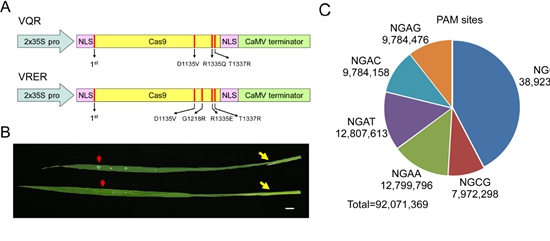分享到
Range of CRISPR/Cas9 Genome Editing is Expanded in Rice
The CRISPR/Cas9 system has emerged as a versatile molecular tool for genome editing in various organisms, including plants. In this system, the specificity of Cas9-directed DNA cleavage strictly requires the presence of a chimeric single guide RNA (sgRNA) and a short trinucleotide proto spacer adjacent motif (PAM) in the genome.
To date, the Cas9 used in plants has only been shown to recognize PAM sequences in the canonical form NGG. As such, the range of sequences for genome editing in plants is limited to sites containing an NGG motif. Recent work has revealed that Cas9 can be modified to recognize alternative PAM sequences in zebrafish and human cells. However, the targeting range limitations in plants have yet to be resolved.
Recently, researchers from China National Rice Research Institute (CNRRI) of Chinese Academy of Agricultural Sciences (CAAS) obtained that two modified SpCas9 variants showed robust genome editing activities at endogenous rice target sites harboring either an NGA or an NGCG PAM, which significantly broadened the range of genome editing. They also detected off-target events in transgenic plants. These results suggest that the specificities of the variants are comparable to that of wild-type Cas9. Taking these findings together, the variants generated in this study enable genome editing in a wider range of plants and could therefore be applied in both basic research and crop breeding in the future.

This work was supported by the National Natural Science Foundation of China, the Zhejiang Provincial Natural Science Foundation of China, and the Agricultural Science and Technology Innovation Program of Chinese Academy of Agricultural Sciences. The research finding has been published in Molecular Plant online on March 17th 2016 (DOI: http://dx.doi.org/10.1016/j.molp.2016.03.003).
More details are available on the links bellow:
http://www.cell.com/molecular-plant/fulltext/S1674-2052(16)00069-1
By Yuan Yiqing
yuanyiqing@caas.cn
To date, the Cas9 used in plants has only been shown to recognize PAM sequences in the canonical form NGG. As such, the range of sequences for genome editing in plants is limited to sites containing an NGG motif. Recent work has revealed that Cas9 can be modified to recognize alternative PAM sequences in zebrafish and human cells. However, the targeting range limitations in plants have yet to be resolved.
Recently, researchers from China National Rice Research Institute (CNRRI) of Chinese Academy of Agricultural Sciences (CAAS) obtained that two modified SpCas9 variants showed robust genome editing activities at endogenous rice target sites harboring either an NGA or an NGCG PAM, which significantly broadened the range of genome editing. They also detected off-target events in transgenic plants. These results suggest that the specificities of the variants are comparable to that of wild-type Cas9. Taking these findings together, the variants generated in this study enable genome editing in a wider range of plants and could therefore be applied in both basic research and crop breeding in the future.

This work was supported by the National Natural Science Foundation of China, the Zhejiang Provincial Natural Science Foundation of China, and the Agricultural Science and Technology Innovation Program of Chinese Academy of Agricultural Sciences. The research finding has been published in Molecular Plant online on March 17th 2016 (DOI: http://dx.doi.org/10.1016/j.molp.2016.03.003).
More details are available on the links bellow:
http://www.cell.com/molecular-plant/fulltext/S1674-2052(16)00069-1
By Yuan Yiqing
yuanyiqing@caas.cn
Latest News
-
 Apr 18, 2024Opening Ceremony of the Training Workshop on Wheat Head Scab Resistance Breeding and Pest Control in Africa Held in CAAS
Apr 18, 2024Opening Ceremony of the Training Workshop on Wheat Head Scab Resistance Breeding and Pest Control in Africa Held in CAAS -
 Apr 03, 2024IPPCAAS Co-organized the Training Workshop on Management and Application of Biopesticides in Nepal
Apr 03, 2024IPPCAAS Co-organized the Training Workshop on Management and Application of Biopesticides in Nepal -
 Mar 28, 2024Delegation from the School of Agriculture and Food Science of University College Dublin, Ireland Visit to IAS, CAAS
Mar 28, 2024Delegation from the School of Agriculture and Food Science of University College Dublin, Ireland Visit to IAS, CAAS -
 Mar 25, 2024Director of World Food Prize Foundation visited GSCAAS
Mar 25, 2024Director of World Food Prize Foundation visited GSCAAS -
 Mar 20, 2024Institute of Crop Sciences (ICS) and Syngenta Group Global Seeds Advance Collaborative Research in the Seed Industry
Mar 20, 2024Institute of Crop Sciences (ICS) and Syngenta Group Global Seeds Advance Collaborative Research in the Seed Industry
